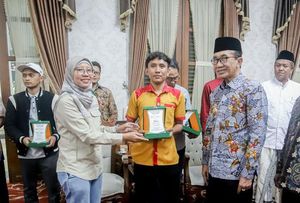Azerbaijan has seen a significant increase in its agricultural exports during the first quarter of 2025, particularly in the apple and potato sectors. According to the State Customs Committee, Azerbaijan exported 28,985.69 tons of apples from January to March 2025. This figure marks a 16.6% increase compared to the same period in 2024. The value of these exports also rose by 17.1%, amounting to $19,340,580 USD. Notably, the share of apple exports in the total exports of Azerbaijan increased slightly to 0.3%, up from 0.28% in the previous year.
Meanwhile, the potato export sector in Kyrgyzstan has also shown robust activity. From January 1 to April 23, 2025, Kyrgyzstan exported a total of 17,017.5 tons of potatoes. This includes 16,894.5 tons of ware potatoes and 123 tons of seed potatoes. The primary importing nations for Kyrgyz potatoes include the Russian Federation, Kazakhstan, Uzbekistan, Azerbaijan, and Belarus.
The export growth in both countries highlights the increasing demand for agricultural products in the region. For Azerbaijan, the apple export surge is particularly noteworthy given the competitive agricultural landscape in the region. The apples exported during this period not only reflect a growing domestic production capacity but also the country's ability to meet international market demands.
In contrast, Kyrgyzstan's potato exports indicate a strong agricultural output, with the majority of its ware potatoes being shipped to neighboring countries. The export figures underscore Kyrgyzstan's strategic position in the Central Asian market, where it continues to supply essential food products to its partners.
Additionally, Kyrgyzstan imported 11,752.8 tons of potatoes during the same timeframe, with 10,019.7 tons being ware potatoes and 1,733.1 tons as seed potatoes. The main exporting countries for these imports include the People's Republic of China, Mongolia, Pakistan, the Netherlands, and Germany. This trade balance illustrates the interconnectedness of agricultural markets in the region.
In Bashkiria, Russia, agricultural exports have also been thriving. In the first three months of 2025, agrarians exported over 66,000 tons of grain, with a total of 1,529 batches shipped to various countries including Azerbaijan, Belarus, Belgium, Germany, India, Kazakhstan, Kyrgyzstan, China, Latvia, Mongolia, Poland, Turkmenistan, Turkey, Uzbekistan, and Switzerland. Among the notable exports from Bashkiria were more than 13,300 tons of oil flax, alongside 2,900 tons of barley, 2,840 tons of rapeseed, over 1,000 tons of mustard, an equal amount of wheat, 460 tons of safflower, and 570 tons of vika and other grain crops.
The diverse range of exports from Bashkiria reflects the region's agricultural strength and its ability to cater to various international markets. The successful shipment of these products is supported by rigorous phytosanitary certification processes conducted by the Russian Federal Service for Veterinary and Phytosanitary Surveillance (Rosselkhoznadzor). This ensures that all exported goods meet the health and safety standards required by importing countries.
During the certification process, samples of the quarantine products underwent thorough testing at the Bashkir testing laboratory under the auspices of Rosselkhoznadzor. Fortunately, no dangerous quarantine organisms or pests were detected in the grains, confirming that all shipments complied with the requirements of the importing nations.
The increasing volumes of agricultural exports from Azerbaijan, Kyrgyzstan, and Bashkiria not only contribute to the economies of these regions but also enhance food security in neighboring countries. As global demand for food products continues to rise, these nations are well-positioned to expand their agricultural markets further.
Experts suggest that the growth in agricultural exports can be attributed to several factors, including improved farming techniques, better access to international markets, and the implementation of supportive government policies aimed at boosting agricultural productivity. As countries in the region continue to develop their agricultural sectors, it is likely that we will see even more significant export increases in the coming years.
In summary, the agricultural exports from Azerbaijan, Kyrgyzstan, and Bashkiria demonstrate a positive trend in the region's ability to supply essential food products both locally and internationally. With continued investment in agriculture and efforts to enhance production capabilities, these countries may further solidify their roles as key players in the global agricultural market.




